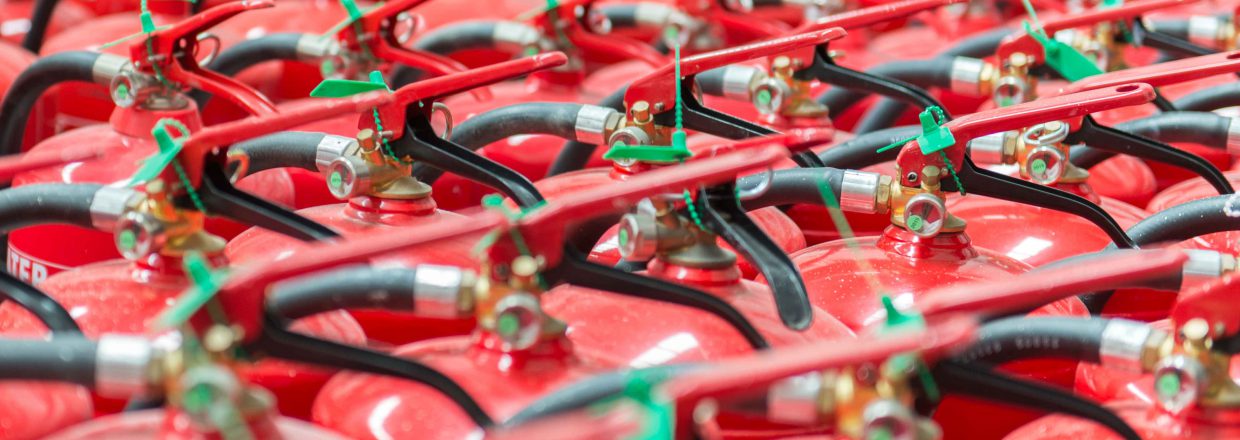Celtic Fire Security offers different fire extinguishers to business and private homes alike. There are five fire extinguisher colours relating to the class of fire they are designed to tackle.
We offer Fire Extinguisher servicing and maintenance packages for business. To make sure you have the right extinguisher for your home please call us to discuss your requirements. We will advise you on the best fire extinguisher types, provide a quote and arrange delivery to your home.
Fire Extinguisher colours
There are 5 classes of fire these are listed as A, B, C, D and F. They correspond to the following:
Class A fires involve materials such wood, fabrics paper
Class B fires involve fuels and oils
Class C fires involve gasses
Class D fires involve metals
Class F fires involve cooking oils mainly in deep fat fryers.
You may see an “E” accompanied by a lightning flash icon, this is an extinguisher, typically Co2 that is safe for use on live electrical equipment although care should be taken as other extinguishers with this symbol have a limitation to the safe voltage they can be used on.
Each extinguisher is designed to operate against 1 or more of the above classes. Extinguishers come in 5 main categories. Within these categories are numerous variants and we will briefly look at these different extinguisher variants. Each category is identified by a colour code and they are as follows:
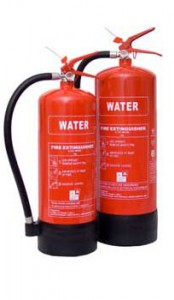 RED indicates a water fire extinguisher suitable for A-rated fires only. Water extinguishers come in many forms. The standard water unit operates as a jet and is best suited for longer distance while water spray units offer a more controllable spray action but are restricted to close proximity. Some water extinguishers carry additives to assist the operation claiming to break down the water to allow better wetting while others are pure water. Water fire extinguishers work by cooling the fire, so removing the heat element from the fire triangle. At Celtic Fire Security we use pure water units as they are environmentally friendly containing only water and nitrogen. Our range includes both jet and spray and our most purchased is the 6ltr water spray extinguisher which is safe for accidental discharge on live electrics, a quite unique device as normally this claim is associated with water additive units.
RED indicates a water fire extinguisher suitable for A-rated fires only. Water extinguishers come in many forms. The standard water unit operates as a jet and is best suited for longer distance while water spray units offer a more controllable spray action but are restricted to close proximity. Some water extinguishers carry additives to assist the operation claiming to break down the water to allow better wetting while others are pure water. Water fire extinguishers work by cooling the fire, so removing the heat element from the fire triangle. At Celtic Fire Security we use pure water units as they are environmentally friendly containing only water and nitrogen. Our range includes both jet and spray and our most purchased is the 6ltr water spray extinguisher which is safe for accidental discharge on live electrics, a quite unique device as normally this claim is associated with water additive units.
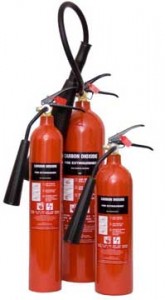 BLACK indicates carbon dioxide, more commonly known as CO2. These extinguishers carry a B rating for safe on fuels, but the main reason they are sold is that they are safe on live electrics. CO2 extinguishers come in 2 common sizes: 2kg and 5kg. The 2kg units have a hard plastic discharge horn located on the side, and the 5kg has a rigid plastic horn at the end of a rubber hose. The discharge is a high pressure jet of liquid CO2 that vaporises in the horn and disperses as a gas. This process creates very low temperatures and can cause the plastic on the horn to freeze. Some horns are double insulated to protect the operator from freeze burns which could occur in extreme cases. CO2 extinguishes fires by removing the oxygen needed to sustain the fire. The effects of the extinguisher are short and as soon as you stop operation the oxygen will return and if not fully extinguished the fire can reignite.
BLACK indicates carbon dioxide, more commonly known as CO2. These extinguishers carry a B rating for safe on fuels, but the main reason they are sold is that they are safe on live electrics. CO2 extinguishers come in 2 common sizes: 2kg and 5kg. The 2kg units have a hard plastic discharge horn located on the side, and the 5kg has a rigid plastic horn at the end of a rubber hose. The discharge is a high pressure jet of liquid CO2 that vaporises in the horn and disperses as a gas. This process creates very low temperatures and can cause the plastic on the horn to freeze. Some horns are double insulated to protect the operator from freeze burns which could occur in extreme cases. CO2 extinguishes fires by removing the oxygen needed to sustain the fire. The effects of the extinguisher are short and as soon as you stop operation the oxygen will return and if not fully extinguished the fire can reignite.
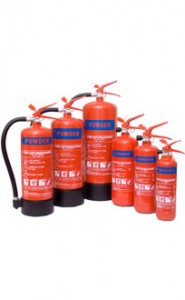 BLUE indicates Dry Powder. The 2 common types of powder are ABC and BC. The ABC is suitable for A,B and C rated fires. The BC is suitable for B and C fires. The former is the most common type and is safe for operation on most types of fire. The latter is suitable for fuel and gas only. Powder extinguishers work by creating a cloud of fine dust which smothers the fire cutting off the oxygen. The cloud of powder can cause reduced visibility and coughing. It may also cause irritation if it gets into your eyes. It is not recommended for confined spaces or in staircases where its reduction of visibility may cause panic or accidents. Use around the elderly is also not recommended as it may trigger off coughing attacks. Unlike CO2 the powder remains working once discharge has finished. However, the fire may still smolder under the cover of the powder and if disturbed can again reignite.
BLUE indicates Dry Powder. The 2 common types of powder are ABC and BC. The ABC is suitable for A,B and C rated fires. The BC is suitable for B and C fires. The former is the most common type and is safe for operation on most types of fire. The latter is suitable for fuel and gas only. Powder extinguishers work by creating a cloud of fine dust which smothers the fire cutting off the oxygen. The cloud of powder can cause reduced visibility and coughing. It may also cause irritation if it gets into your eyes. It is not recommended for confined spaces or in staircases where its reduction of visibility may cause panic or accidents. Use around the elderly is also not recommended as it may trigger off coughing attacks. Unlike CO2 the powder remains working once discharge has finished. However, the fire may still smolder under the cover of the powder and if disturbed can again reignite.
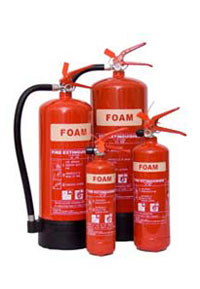 CREAM indicates Foam. The foam extinguisher comes in 3 common sizes: 2ltr, 6ltr and 9ltr. The foam extinguisher carries a double fire rating covering A and B risks and is very efficient with contained fuel fires as it forms a skin on the top of the liquid. If the skin is disturbed it will immediately start to reform, re-extinguishing the fire. The 6ltr Foam is commonly found in office environments as it was the first water based extinguisher that was graded as safe for accidental discharge against live electrics. The foam works in 2 ways: on A rated fires (wood paper fabric etc) where it cools the same way water does, and on fuel fires it works by smothering the fire and sealing the fuel from the oxygen. The downside to the Foam in the office environment is the environmental issues with discharging.
CREAM indicates Foam. The foam extinguisher comes in 3 common sizes: 2ltr, 6ltr and 9ltr. The foam extinguisher carries a double fire rating covering A and B risks and is very efficient with contained fuel fires as it forms a skin on the top of the liquid. If the skin is disturbed it will immediately start to reform, re-extinguishing the fire. The 6ltr Foam is commonly found in office environments as it was the first water based extinguisher that was graded as safe for accidental discharge against live electrics. The foam works in 2 ways: on A rated fires (wood paper fabric etc) where it cools the same way water does, and on fuel fires it works by smothering the fire and sealing the fuel from the oxygen. The downside to the Foam in the office environment is the environmental issues with discharging.
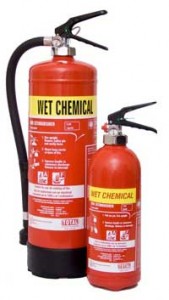 YELLOW indicates Wet Chemical or sometimes called Class F. These are specialist extinguishers and are designed purely for use on deep fat fryers, They are much more effective at tackling a deep fat fire than other mediums. They solidify the fat forming a soap like mix through a chemical reaction to extinguish the fire and prevent re-ignition. These extinguishers are available in 2 sizes depending on the size of the fryers on site and when operated they must be fully discharged into the container in order for them to work correctly. In addition to the fryers they can be used on Class A and B fires but the additional chemicals within the extinguisher can make the area sprayed very slippery.
YELLOW indicates Wet Chemical or sometimes called Class F. These are specialist extinguishers and are designed purely for use on deep fat fryers, They are much more effective at tackling a deep fat fire than other mediums. They solidify the fat forming a soap like mix through a chemical reaction to extinguish the fire and prevent re-ignition. These extinguishers are available in 2 sizes depending on the size of the fryers on site and when operated they must be fully discharged into the container in order for them to work correctly. In addition to the fryers they can be used on Class A and B fires but the additional chemicals within the extinguisher can make the area sprayed very slippery.

